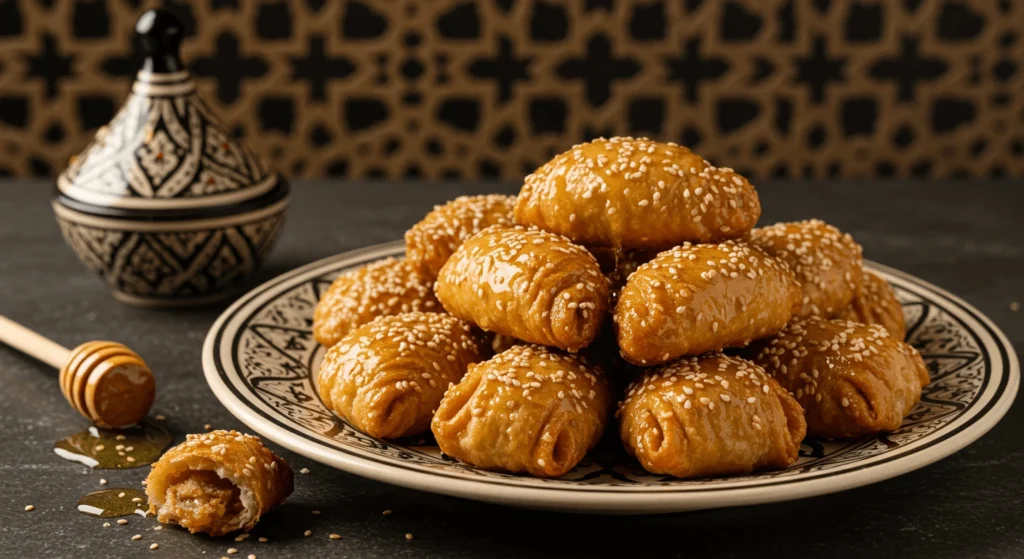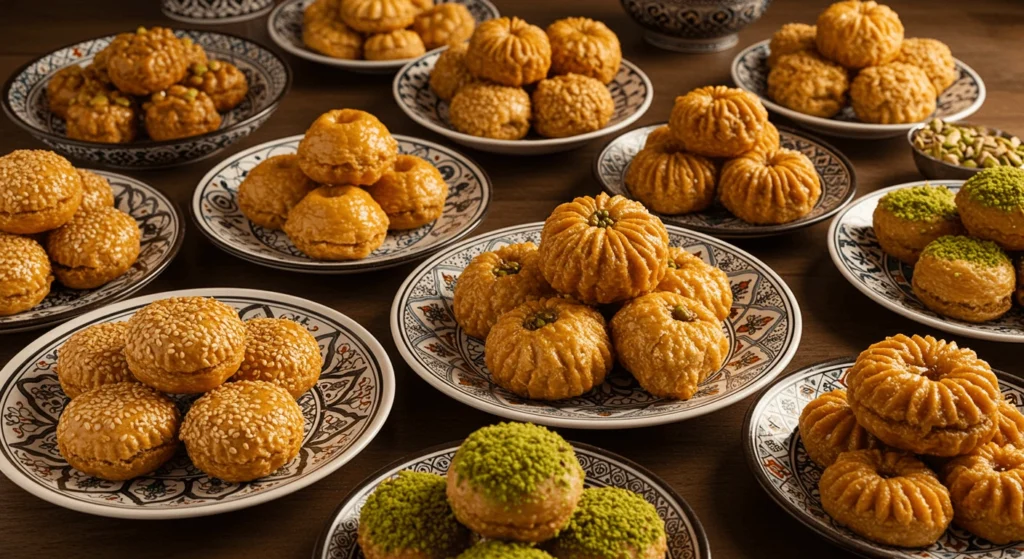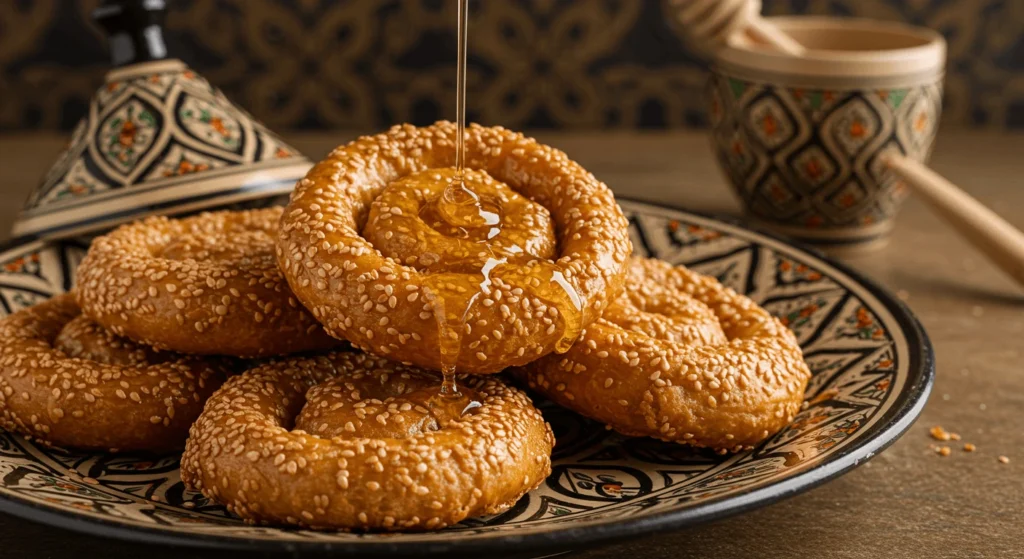
Introduction
The first time I tasted chebakia was during Ramadan in a small family home in Fez, Morocco. As the intricate honey-soaked pastries were passed around on ornate silver platters, I was captivated not just by their distinctive flower shape, but by the complex blend of spices that seemed to tell the story of Morocco’s rich culinary heritage in a single bite.
Chebakia, the beloved Moroccan sesame and honey cookie, holds a special place in North African cuisine, particularly during Ramadan and special celebrations. What makes these twisted pastries so extraordinary is the careful balance of aromatic spices, the rich nuttiness of toasted sesame seeds, and the intoxicating sweetness of honey infused with orange blossom water. While they may look intimidating to prepare, selecting the right ingredients is half the battle in creating truly authentic chebakia that would make any Moroccan grandmother proud.

Recipe Card/Summary Box
Prep Time: 1 hour (plus 8 hours resting time)
Cook Time: 30 minutes
Total Time: 9 hours 30 minutes
Servings/Yield: Approximately 40-50 pieces
Difficulty Level: Intermediate
Estimated Cost: $15-20
Ingredient List
For the Dough:
- 4 cups (500g) all-purpose flour
- 1/2 cup (100g) fine semolina flour
- 1/4 teaspoon salt
- 1 teaspoon ground cinnamon
- 1 teaspoon ground anise seeds
- 1 teaspoon ground fennel seeds
- 1/2 teaspoon ground coriander
- 1/4 teaspoon ground nutmeg
- 1/4 teaspoon ground mastic gum (optional but traditional)
- 1/2 cup (120ml) melted unsalted butter
- 1/2 cup (120ml) olive oil (use light olive oil, not extra virgin)
- 2 large eggs, room temperature
- 1/4 cup white vinegar
- 1 tablespoon baking powder
- 1/4 cup orange flower water
- 1-2 tablespoons toasted sesame seeds, finely ground
For the Honey Syrup:
- 4 cups (1 liter) high-quality honey
- 1 cup (240ml) water
- 2 tablespoons orange blossom water
- 1 cinnamon stick
- 1/4 teaspoon salt
For Decoration:
- 1 cup (150g) toasted sesame seeds
- Optional: 2 tablespoons ground almonds for sprinkling
Substitutions:
- For gluten-free: Replace regular flour with gluten-free all-purpose flour blend plus 1 teaspoon xanthan gum (texture will be slightly different)
- For vegan version: Replace eggs with 4 tablespoons aquafaba and use plant-based butter
- If mastic gum is unavailable: Increase anise and fennel slightly for a similar aromatic quality
- If orange blossom water is unavailable: Use rose water or a combination of orange zest and vanilla extract
Special Ingredients Note:
- Mastic gum (Arabic: مصطكى “mastika”): This resin from the mastic tree provides a distinctive pine-like flavor. Find it in Middle Eastern or specialty grocery stores.
- Orange blossom water: Essential for authentic flavor, available in Middle Eastern markets, gourmet shops, or online.
- Semolina flour: Adds texture to the dough; look for fine-ground semolina rather than coarse.
Equipment Needed
Essential Tools:
- Kitchen scale (for precise measurements)
- Stand mixer with dough hook (or large mixing bowl for hand kneading)
- Rolling pin
- Sharp knife or pastry wheel
- Slotted spoon
- Deep fryer or large, deep pot
- Candy/frying thermometer
- Fluted pastry wheel (for traditional decorative edges)
- Mesh strainer or slotted spoon
- Large shallow dishes for soaking in honey
Alternatives:
- No stand mixer? Hand kneading works well but requires about 20 minutes of kneading
- No fluted pastry wheel? A pizza cutter or sharp knife works for straight cuts
- No deep fryer? Any large, heavy-bottomed pot works well
Step-by-Step Instructions
- Prepare the spice mixture: In a small bowl, combine cinnamon, anise, fennel, coriander, nutmeg, and mastic gum (if using). Grind together using a mortar and pestle or spice grinder until finely powdered. This ensures even distribution of flavors throughout the dough.
- Mix the dry ingredients: In a large bowl, whisk together flour, semolina, salt, and the prepared spice mixture. Make a well in the center.
- Combine wet ingredients: In a separate bowl, beat the eggs lightly, then add melted butter, olive oil, vinegar, and orange flower water. Mix until well combined.
- Form the dough: Pour the wet ingredients into the well of dry ingredients. Mix with a wooden spoon until just combined, then add the baking powder and ground sesame seeds. Knead for about 10 minutes until smooth and elastic. The dough should be soft but not sticky. If too sticky, add a little more flour; if too dry, add a few drops of orange flower water.
- Rest the dough: Divide the dough into 4 equal portions, shape into balls, cover with plastic wrap and let rest at room temperature for 15 minutes. Then transfer to the refrigerator and let rest overnight (or at least 8 hours). This resting period is crucial for flavor development and proper texture.
- Shape the chebakia: On a lightly floured surface, take one portion of dough and roll it out to about 1/8 inch (3mm) thickness. Using a pastry wheel, cut into rectangles approximately 2×4 inches (5x10cm). Make 3-4 evenly spaced cuts in the center of each rectangle, leaving the edges intact.
- Create the flower shape: Take one rectangle, thread one end through the center cut, and pull gently to create a twist. Pinch the ends together to form a flower-like shape. Place on a floured tray and cover with a cloth. Repeat with remaining dough.
- Heat the oil: In a deep fryer or large pot, heat vegetable oil to 320-330°F (160-165°C). Test with a small piece of dough – it should bubble gently and rise to the surface without browning too quickly.
- Fry the chebakia: Working in small batches (4-5 pieces at a time), carefully drop the shaped dough into the hot oil. Fry for about 4-5 minutes, turning occasionally, until golden brown on all sides. They should be crisp on the outside but still slightly chewy inside. Be vigilant with temperature control – if too hot, they’ll brown before cooking through; if too cool, they’ll absorb too much oil.
- Prepare the honey syrup: While frying, combine honey, water, cinnamon stick, and salt in a large pot. Bring to a gentle simmer over medium-low heat, stirring occasionally. Once simmering, reduce heat to low and keep warm.
- Honey soak: As soon as the chebakia are fried, use a slotted spoon to transfer them directly into the warm honey syrup. Let soak for 5-7 minutes, gently turning occasionally to ensure even coating.
- Drain and garnish: Remove the chebakia from the syrup with a slotted spoon, letting excess honey drip off. Place on a wire rack set over a baking sheet to catch drips. Immediately sprinkle with toasted sesame seeds and optional ground almonds before the honey dries.
- Final set: Allow to set for at least 30 minutes before serving. The chebakia will firm up slightly as they cool, creating the perfect balance of crisp exterior and chewy center.

Nutrition Information
Per piece (approximately):
- Calories: 180
- Total Fat: 7g
- Saturated Fat: 2g
- Carbohydrates: 28g
- Sugars: 18g
- Protein: 2g
- Fiber: 1g
- Sodium: 40mg
Allergens: Contains wheat, eggs, and sesame seeds. May contain traces of tree nuts if almonds are used for garnish.
Recipe Tips and Variations
Common Mistakes to Avoid:
- Skipping the overnight rest: This is essential for developing flavor and proper texture
- Rolling dough too thin or thick: Aim for consistent 1/8 inch thickness
- Frying at improper temperature: Use a thermometer to maintain 320-330°F
- Over-soaking in honey: 5-7 minutes is sufficient; longer soaking can make them too sweet and soggy
- Using low-quality honey: The honey flavor is prominent, so use the best quality you can afford
Make-Ahead Instructions:
- The dough can be prepared up to 2 days in advance and kept refrigerated
- Shaped (but unfried) chebakia can be frozen for up to 1 month; thaw in refrigerator before frying
- Fried but not yet honey-soaked chebakia can be stored in an airtight container for 2-3 days before soaking
Storage and Preservation:
- Store finished chebakia in a single layer in an airtight container at room temperature for up to 2 weeks
- For longer storage, separate layers with parchment paper
- If they begin to dry out, briefly warm in a low oven (250°F/120°C) for 3-5 minutes
Regional Variations:
- Fez style: More pronounced anise flavor and darker honey soak
- Tetouan style: Addition of lemon zest to the dough
- Modern variation: Add 1/4 teaspoon ground cardamom for an aromatic twist
- Less sweet version: Reduce honey soak time to 2-3 minutes
Serving Suggestions
Traditional Accompaniments:
- Moroccan mint tea (sweetened with honey rather than sugar to complement the chebakia)
- Harcha (semolina bread)
- Dates and dried fruits
- Serve as part of a complete Moroccan breakfast with beghrir (thousand-hole pancakes)
Presentation Ideas:
- Arrange in a spiral pattern on a round silver tray for traditional presentation
- Dust lightly with powdered sugar for elegant contrast with the honey glaze
- Serve individually in decorative cupcake liners for modern gatherings
- Create a dessert board with chebakia, dates, nuts, and fresh fruit

Frequently Asked Questions
What is chebakia made of? Chebakia is made from a spiced dough containing flour, semolina, eggs, butter, and a blend of spices including cinnamon, anise, and fennel. After frying, the pastries are soaked in honey flavored with orange blossom water and garnished with sesame seeds.
How to cut chebakia? Traditional chebakia requires cutting rectangles of dough (approximately 2×4 inches) and making 3-4 evenly spaced cuts in the center without cutting through the edges. The dough is then folded by threading one end through the center cut to create the characteristic flower shape.
Can you freeze chebakia? Yes, chebakia can be frozen either before or after frying. Unfried shaped pastries can be frozen for up to a month and fried directly from frozen (add 1-2 minutes to frying time). Fully prepared chebakia (after honey soaking) can be frozen for up to 3 months, though the texture may change slightly upon thawing.
What is a Moroccan breakfast? A traditional Moroccan breakfast typically includes bread (such as khobz or msemen), olive oil, honey, soft cheese, dates, olives, eggs, and sweet pastries like chebakia. This is often accompanied by mint tea and fresh orange juice. During Ramadan, chebakia is especially popular for breaking the fast.
How many calories are in chebakia? Each piece of chebakia contains approximately 180 calories, though this can vary based on size and how much honey is absorbed. They are considered a treat food due to their high sugar and fat content.
What does chebakia taste like? Chebakia has a complex flavor profile combining warm spices (cinnamon, anise, fennel) with the floral notes of orange blossom water. The texture contrast between the crisp, fried exterior and chewy interior is complemented by the rich sweetness of honey and the nutty flavor of sesame seeds.
Reader Engagement Prompt
Have you tried making chebakia at home? I’d love to see how your flower-shaped treats turned out! Share your photos in the comments below or tag us on social media with #ChebakiaSuccess.
Do you have a family recipe for chebakia with different spices or techniques? What challenges did you face when making them? Share your experiences and questions below – I respond to every comment and love learning about different regional variations of this beloved Moroccan sweet!
